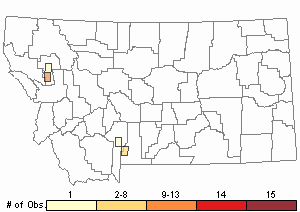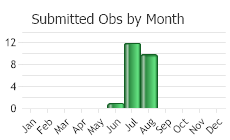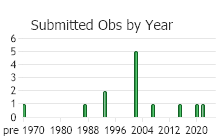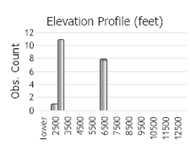View in other NatureServe Network Field Guides
NatureServe
Montana
Utah
Wyoming
Idaho
Wisconsin
British Columbia
South Carolina
Yukon
California
New York
Oregon Checker-mallow - Sidalcea oregana
Other Names:
Sidalcea organa ssp. oregana
State Rank Reason (see State Rank above)
Known from two widely separate sites in Gallatin and Lake counties. Habitats occupied by the species are susceptible to weed invasion and both locations have a large component of weedy species. However, S. oregana appears capable of tolerating at least some competition from these weedy species. The Lake County population occurs near and along Highway 93 and has the potential to be significantly negatively impacted by highway construction.
- Details on Status Ranking and Review
Population Size
Score1-2 - Small to Moderate. Population size is imprecisely known but is believed to be >2,000 individuals and <100,000 individuals.
Range Extent
Score1 - Peripheral, Disjunct or Sporadic Distribution in MT: Widespread species that is peripheral, disjunct or sporadically distributed within MT such that it occurs in <5% of the state (<7,500 sq. miles or the combined area of Beaverhead and Ravalli Counties) or is restricted to 4-5 sub-basins.
Area of Occupancy
Score3 - Very Low: Generally occurring in 3 or fewer Subwatersheds (6th Code HUC’s).
Environmental Specificity
Score1 - Moderate: Species is restricted to a specific habitat that is more widely distributed or to several restricted habitats and is typically dependent upon relatively unaltered, good-quality habitat (C Values of 5-7).
CommentAppears to be tolerant of some level of disturbance.
Trends
Score1-3 - Declining: Species is likely declining though the magnitude of declines is uncertain. Declines may be based upon range extent and/or occupied area in the recent past (approximately 30 years).
CommentTrends are unknown, though may be declining due to impacts to habitat quality. Road construction and invasive species may have detrimentally impacted the populations.
Threats
Score2-3 - High to Very High.
Intrinsic Vulnerability
Score0-1 - Low to Moderate Vulnerability.
Raw Conservation Status Score
Score
9 to 14 total points scored out of a possible 19.
General Description
Oregon Checker-mallow is an herbaceous perennial with erect stems that are 2-15 dm tall and arising from a branched rootcrown that surmounts a taproot. The basal leaves have long petioles and round blades that are deeply palmately divided into 5-9 nearly linear lobes. The alternate stem leaves become smaller with few lobes upward. The lower stems and leaves are sparsely covered with star-shaped hairs. Short-stalked flowers are borne in a terminal spike. Some flowers are bisexual, while in others, the anthers are sterile or lacking. Each pink flower has a 5-lobed, hairy calyx that is 4-9 mm long and 5 separate, oblong, shallowly bilobed petals that are 15-20 mm long. Numerous stamens are united into a tube surrounding the style. The numerous stigmas are linear. The fruit, which is 2-3 mm long, is a flattened-globose capsule with many sections, giving it the appearance of a peeled orange.
Phenology
Flowering in the end of June-mid-August, fruiting in late August.
Diagnostic Characteristics
Iliamna rivularis has leaves with broader lobes and globose stigmas.
Species Range
Montana Range
Range Descriptions

 Native
Native
Range Comments
B.C. to CA, east to MT, WY, and UT. Peripheral.
Observations in Montana Natural Heritage Program Database
Number of Observations: 24
(Click on the following maps and charts to see full sized version)
Map Help and Descriptions
Relative Density

Recency



 (Observations spanning multiple months or years are excluded from time charts)
(Observations spanning multiple months or years are excluded from time charts)
Habitat
Grasslands in the valley and montane zones.
Ecological Systems Associated with this Species
- Commonly Associated with these Ecological Systems
Grassland Systems
Stewardship Responsibility
Threats or Limiting Factors
STATE THREAT SCORE REASON
Reported threats to Montana's population of Oregon Checker-mallow refer to competition from non-native plants and additional impacts of road construction and maintenance (MTNHP Threat Assessment 2021). Co-occurring non-native grasses and noxious weeds including Smooth brome (Bromus inermis), Common St. John's-wort (Hypericum perforatum), Canada thistle (Cirsium arvense), and Toadflax (Linaria sp.) pose complex challenges at both Oregon Checker-mallow populations. A major population located along Highway 93 is also exposed to road construction and maintenance, where impacts to stressed populations are potentially amplified.
References
- Literature Cited AboveLegend:
 View Online Publication
View Online Publication MTNHP Threat Assessment. 2021. State Threat Score Assignment and Assessment of Reported Threats from 2006 to 2021 for State-listed Vascular Plants. Botany Program, Montana Natural Heritage Program, Helena, Montana.
MTNHP Threat Assessment. 2021. State Threat Score Assignment and Assessment of Reported Threats from 2006 to 2021 for State-listed Vascular Plants. Botany Program, Montana Natural Heritage Program, Helena, Montana.
- Additional ReferencesLegend:
 View Online Publication
View Online Publication
Do you know of a citation we're missing? Lesica, P., M.T. Lavin, and P.F. Stickney. 2012. Manual of Montana Vascular Plants. Fort Worth, TX: BRIT Press. viii + 771 p.
Lesica, P., M.T. Lavin, and P.F. Stickney. 2012. Manual of Montana Vascular Plants. Fort Worth, TX: BRIT Press. viii + 771 p. Lesica, P., M.T. Lavin, and P.F. Stickney. 2022. Manual of Montana Vascular Plants, Second Edition. Fort Worth, TX: BRIT Press. viii + 779 p.
Lesica, P., M.T. Lavin, and P.F. Stickney. 2022. Manual of Montana Vascular Plants, Second Edition. Fort Worth, TX: BRIT Press. viii + 779 p. Vanderhorst, J.P. 1994. Sensitive plant surveys in the Gallatin National Forest, Montana. Unpublished report to the Gallatin National Forest. Montana Natural Heritage Program, Helena, MT. 54 pp.
Vanderhorst, J.P. 1994. Sensitive plant surveys in the Gallatin National Forest, Montana. Unpublished report to the Gallatin National Forest. Montana Natural Heritage Program, Helena, MT. 54 pp.
- Web Search Engines for Articles on "Oregon Checker-mallow"





